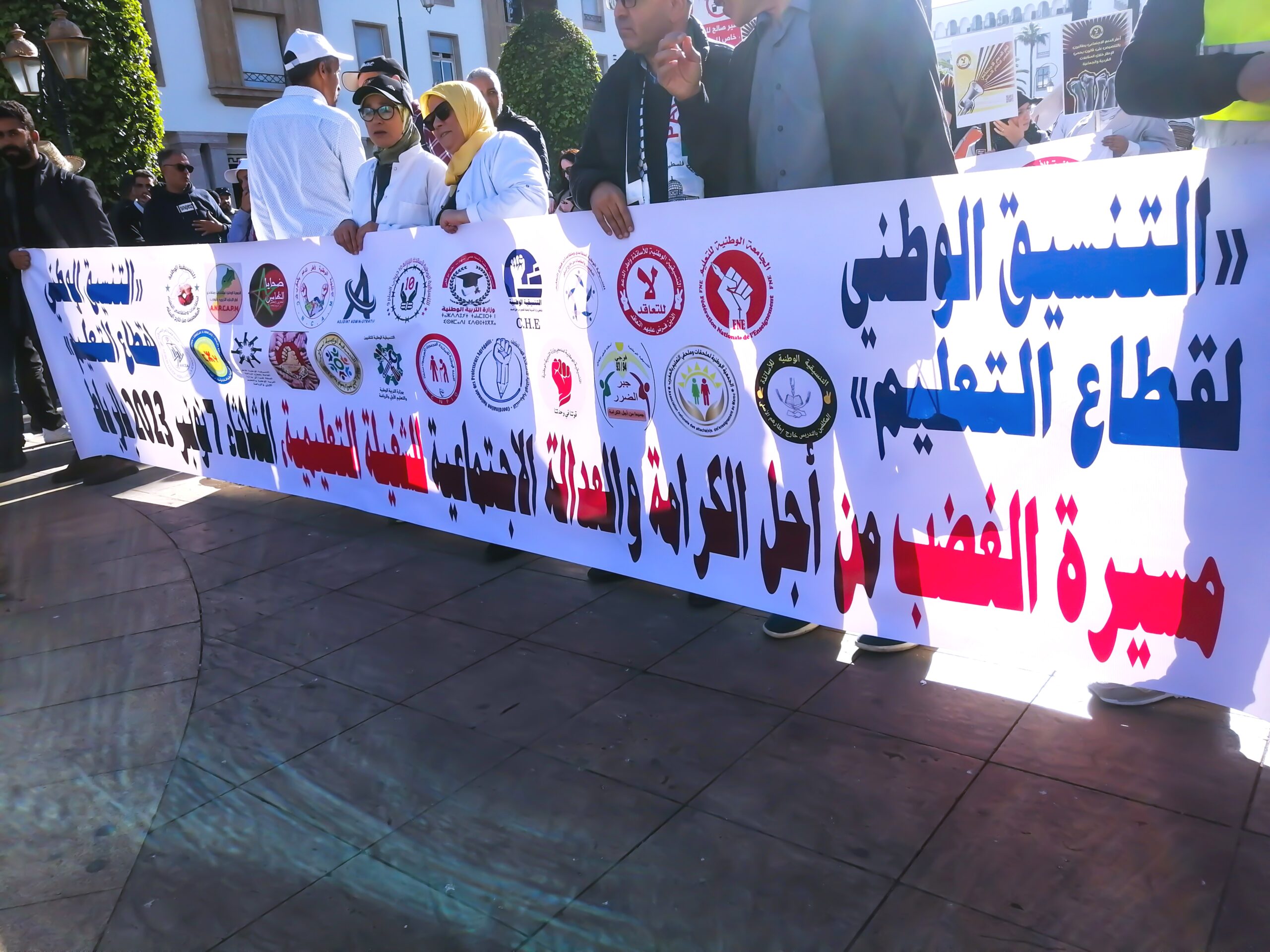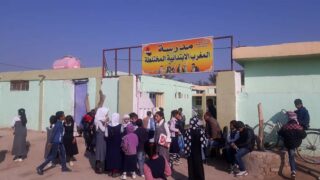The current school year began with its usual routine: receiving students, characterizing and evaluating their previous educational acquisitions, and numerous routine administrative procedures… Then suddenly, without fully taking into account the opinions of those concerned, the teachers were surprised by the issuance of the statutory decree for employees of the Ministry of Education at the end of September 2023. The decree consists of laws that specify their duties, rights, promotion format, ranks, and job details.
Later, signs of congestion surfaced in the scene, the first of which was the strike on the 5th of October, coinciding with International Teachers' Day, which achieved a participation rate of more than 90% among teachers. The ministry did not respond instantaneously to the message, and it continued its usual “procrastination” in light of almost complete paralysis of public schools due to the teachers’ ongoing protests and strikes, unprecedented in the history of the country’s educational movement.
“Down with the fundamentally tragic system!”
October had fewer strike days, representing a protest strategy aimed at exerting gradual pressure on the Ministry of Education, which remained silent for a long time until it issued an official statement saying that the law would be “improved” based on the agreements supposed to take place between the ministry and the education unions.
Passing Students: None
05-01-2024
However, this proposal was deemed a ‘‘tactic” by the ministry (as described by teachers), with the intention of procrastinating, buying time, and then imposing the basic system on teachers after they are exhausted of strikes, protests, and marches. Despite this, the teachers persisted in their strike for 18 days during the month of November, including a national march on the 7th which was the largest in the history of the educational movement in Morocco. Press and union sources report the presence of more than tens of thousands of demonstrators who roamed the most vital streets of Rabat, the capital, shouting in unison: “Teachers say down with the system! The fundamentally tragic system!”
The ministry’s hidden goal is to gradually reduce the wage pool of its employees, teachers in specific, as they constitute the largest group in public jobs, with a population of more than a quarter of a million teachers. The government views this significant number as a ‘‘burden’’ on its treasury and finances, some of which rely on loans offered by international lending institutions.
The pressure from this protest began to bear fruit in late November when the ministry summoned the most representative unions[1] for dialogue, without summoning the actual representatives[2] of each occupational category, which are: the National Coordination for the Education Sector[3], the Unified Coordination of Educational Workers, Educational Support Frameworks, and National Coordination of Secondary Education Teachers.
The ministry neglected the teachers’ demands for about a month before making them an offer that did not fully satisfy them. The proposal suggested a temporary suspension of the process of deducting from the wages of strikers, abolishing the penalties outlined in this system and replacing them with previous penalties, and discussing ‘‘improving teachers’ income’’ and raising their wages. What is even stranger is the decision to “freeze” this system, a move met with disapproval by the teacher community that has been demanding the complete withdrawal of the system from the outset.
The “freeze” prompted not only ridicule from teachers but also from parents, who showed unprecedented solidarity with teachers. The term “freezing” was considered illegal and only valid for food supplies that are cooled in the refrigerator and then eaten when needed. This applies to this “frozen” law, which will be resorted to in circumstances that suit the ministry’s policy.
On the other hand, the ministry demonstrated what it described as “a good intention” by issuing a written statement signed by key stakeholders parties in the dialogue, including the unions with highest representation, the Minister of Education, the Minister of Economy and Finances, and the Minister of Employment who was proposed as a negotiator by the Prime Minister to absorb the tension, and the rest of the factional and technical demands, who were called for discussion during the first week of December 2023. However, this “intention”, articulated by the Prime Minister, was not actually implemented. Evidence of this lies in the fact that massive deductions[4] affected the majority of strikers even though he had promised that this would not happen. This raises a pertinent question: How can those affected place trust in the promises of politicians, especially at a time when students are forced to waste and lose valuable school time?
“We do not want to freeze our children’s schooling!”
“We are tired of this procrastination. The issue needs no delay!”
“We do not want to freeze our children’s schooling!”
These slogans were echoed by teachers and the majority of parents of the students, who got tired from this worsening situation because students were getting their school time wasted, while their futures became uncertain after much delay. Both the ministry and the government were held accountable for this crisis, as they failed to respond effectively to the demands, causing distress among students and their families.
The movements involved the mothers and fathers of students, so they, accompanied by their children, went to the streets on an almost regular basis in front of the educational departments and institutions. Their sense of injustice increased in front of the scene of the regular attendance by private education students and their daily benefit from their right to education, because this strike is carried out solely by public sector teachers, even though their counterparts in the private education sector are in no better position[5].
Faced with this reality, many families have opted for transferring their children to private schools, which are witnessing a surges in demand year after year. In the last school season, over 61 thousand students switched from public schools to private ones with an increase of approximately 18% compared to the previous school season.
Is there a complete and radical solution for this problem? Parents of the students ask. Certainly, there is a semi-solution: providing quick support to the students during the school break!
Morocco: A Kingdom of Rent
18-04-2022
Morocco: Who Owns the Land?
01-11-2022
The Ministry resorted to adopting a patchwork solution providing educational support during the one-week school break from December 4 in public schools as a way to “save” wasted school time. However, phases of this semi-educational process have encountered numerous errors, improvisations, and problems. Fresh university graduates and trainee teachers were hired for the job, but most of them found dealing with students in these classes extremely challenging. A beginner teacher or fresh graduate cannot undertake such a task without being equipped with sufficient theoretical and practical training in this field. Those of them who had any training have taken a rushed version of a one-day workshop that does not adhere to the methodological stages applicable in teacher training centers. Another fundamental question raised by educators and teachers is: ‘‘How can students who have had limited schooling be effectively supported? Support is a phase that comes after having taken all lessons and after having been properly evaluated, not before. The entire process of “support” is therefore absurd!”
Many families have opted for transferring their children to private schools, which are witnessing a surges in demand year after year. In the last school season, over 61 thousand students switched from public schools to private ones with an increase of approximately 18% compared to the previous school season.
In turn, a significant segment of students' parents echoed the sentiments of the teachers and called for boycotting these support classes, after some photos were leaked on social media revealing glaring deficiencies in teachers in the classrooms, weak linguistic and grammatical skills in both French and Arabic languages, coupled with their use of impromptu educational and cognitive content of the lessons. This patchwork situation has increased the frustration of teachers who feel aggrieved by a law that “does not do justice to them”.Top of Form
Nine billion dirhams for the system. Zero for the teachers!
The Ministry of Education defends the new fundamental system because it legally ‘‘preserves the previous gains’’ of its employees, meets the demand for unifying professional paths for all categories, and involves many incentives that basically include the head of teachers and educational support frameworks such as school principals, educational inspectors, heads of departments, directorates, and academies[6]. Under this system, teachers are set to receive incentives of both a professional and administrative nature, including promotions to first-degree positions. Furthermore, it pledges to incorporate contract teachers into the promotion framework, aligning them with the ranks and professional ladders applicable to other categories.
The implementation of this new system costs around 9 million dirhams ($900 million approximately), translating to an annual rate estimated at approximately 2.5 billion dirhams (about $250 million), from which teachers will not see a penny. Meanwhile, this law imposes additional burdens and tasks outside the scope of teaching, including supervising educational clubs and organizing cultural and sporting activities, and participating with the administrative team in some administrative and semi-administrative tasks.
Prescriptions of international lending institutions
This system is described as ‘‘unfair’’ and seen as a sharp downgrade from the former fundamental system of 2003. Its first lines indicate that the ministry has no intention of uniting its teachers, as it continues to differentiate between registered teachers and those in academic frameworks, namely contractors, without integrating them like their colleagues who have a tenured position in the public job.
The "Gloomy" Economy of Morocco
15-07-2019
It appears that the ministry’s new law aims to gradually unify the teachers within a unified professional framework. Hence, they must be labeled under “academic frameworks” and should be administratively affiliated with institutions managing this sector regionally, in order to implement the project of ‘‘advanced regionalization’’[7], and to gradually break away from the exhausting centralization of the sector’s bureaucratic structure. Sounds good, right?
The Ministry resorted to adopting a patchwork solution providing educational support during the one-week school break from December 4 in public schools as a way to “save” wasted school time. However, phases of this semi-educational process have encountered numerous errors, improvisations, and problems.
In reality, this is good for the ministry, but it is not in the interest of teachers, as the ministry’s hidden goal is to gradually reduce the wage pool of its employees, teachers in specific, as they constitute the largest group in public jobs, with a population of more than a quarter of a million male and female teachers[8]. The government views this significant number as a ‘‘burden’’ on its treasury and finances, some of which rely on loans offered by international lending institutions[9]. What is the prescribed remedy, then? Simply include contract teachers (estimated to be about half the number of teachers) in the “equipment” budget for regional academies, and remove them from the state’s “expensive” “personnel expenses” budget. This reduces the government’s expenses incurred in financial positions that are marked and approved annually. Therefore, the number of this category will increase in upcoming seasons, while the number of the registered teachers will decrease due to retirement, which has reached record numbers in recent years[10].
The teachers’ demands are:
1- Withdrawal of the fundamental system for employees of the Ministry of National Education.
2- Increase in teachers’ wages.
3- Abolition of the contracting system in its various titles and manifestations.
4- Implementation of the agreements between the government/ Ministry of Education and the teachers’ union movement: 19 April 2011, 26 April 2011, 18 January 2022.
5- Tax reduction for wages and compensation along with cancellation of tax deductions for wages.
6- Cancellation of overtime support hours.
7- Halting all illegal deductions from the salaries of strikers and refunding all amounts deducted from their salaries.
8- Democratization of Mohammed VI Foundation for the Promotion of Social Works of the Education-Training and the Mutual General of National Education (MGNE).
9- Justice for teachers holding BA and MA degrees who participated in protests for degree promotion during the year 2013.
10- Immediate processing of all outstanding files of categorical groups, based on the demands of each.
11- Revocation of all “disciplinary” punitive measures and penalties issued against teachers, and cancellation of all prosecutions against them.
12- A formal government apology to all educators.
Translated from Arabic by Maher El-Kechen
Published in Assafir Al-Arabi on 17/12/2023
1-The National Education Union affiliated with the Democratic Federation for Labor (CDT), National Federation for Education (FNE), the National Education Union affiliated with the Democratic Confederation for Labor, and the Free University of Education. ↑
2-Most public teachers do not trust the education unions because, according to them, the unions have “colluded” with the ministry and the government in not fully meeting their demands. ↑
3-This entity includes 22 coordination committees, including many categories of teachers and employees of the public education sector. ↑
4-It averaged between 500 and 1500 dirhams (between $50 and $150). ↑
5-The majority of teachers in private education receive a wage equivalent to the minimum wage in the private sector (About 3120 dirhams; $310) or less. ↑
6-A governmental organization representing the tasks of the Ministry of Education and managing its affairs at the regional level. ↑
7-A project through which the authorities seek to gradually cut off the mechanisms of central management of the country’s affairs. ↑
8-The total number of teaching staff reached 269,015 teachers during the school season 2022/2023. ↑
9-Morocco obtained a loan to finance education with a value of $250 million during March 2023. ↑
10-The number of retiring employees will reach 33,017 in the coming five years. ↑





